Papers by Tester Ashavaid
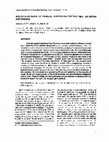
Indian Journal of Clinical Biochemistry, Aug 1, 2000
Familial hypercholesterolemia (FH) is an autosomal dominant disease caused by a multitude of low-... more Familial hypercholesterolemia (FH) is an autosomal dominant disease caused by a multitude of low-density lipoprotein (LDL) receptor gene mutations. The LDL receptor is a cell surface trans-membrane protein that mediates the uptake & lysosomal degradation of plasma LDI., thereby providing cholesterol to cells. Affected individuals have elevated plasma levels of LDL, which causes premature coronary atherosclerosis. FH has an estimated worldwide prevalence of 0.2%. In some subpopulations there is an increased frequency of FH and specific LDL receptor mutations are found to be common due to 'founder gene effect'. Overall, more than 300 naturally occurring LDL receptor mutations have been described. To date upto ten LDL receptor gene mutations have been identified in Indians in South Africa, suggesting increased incidence of FH among Indians. Most mutations have occurred at CpG dinucleotide, a mutational hotspot in human genetic disease. In our study in 25 hypercholesterolemic subjects we have identified two novel insertion mutations in two patients. But the mutations underlying FH are still undefined in the majority of cases. Mutational heterogeneity on the other-hand has complicated disease diagnosis at DNA level. These findings warrant application of a generalized mutation screening method in search for new LDL receptor gene defects.
Clinical Chemistry and Laboratory Medicine, 1998
ABSTRACT
Clinical Chemistry, Aug 1, 2000
Cornell University Press eBooks, Dec 31, 2020
Journal of Crohn's and Colitis, Jan 16, 2018
Clinica Chimica Acta
Elsevier has created a COVID-19 resource centre with free information in English and Mandarin on ... more Elsevier has created a COVID-19 resource centre with free information in English and Mandarin on the novel coronavirus COVID-19. The COVID-19 resource centre is hosted on Elsevier Connect, the company's public news and information website. Elsevier hereby grants permission to make all its COVID-19-related research that is available on the COVID-19 resource centre-including this research content-immediately available in PubMed Central and other publicly funded repositories, such as the WHO COVID database with rights for unrestricted research re-use and analyses in any form or by any means with acknowledgement of the original source. These permissions are granted for free by Elsevier for as long as the COVID-19 resource centre remains active.
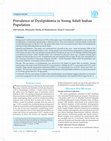
PubMed, Feb 1, 2008
Background: Cardiovascular diseases (CVD) are the major cause of morbidity and mortality in our s... more Background: Cardiovascular diseases (CVD) are the major cause of morbidity and mortality in our society with dyslipidemia contributing significantly to atherosclerosis. Thus measurement of plasma lipids would help in identifying people at risk for CVD. The goal of this study was to ascertain the prevalence of Dyslipidemia among young adult population in urban India. Material and methods: The study was conducted for a period of one year--from 1st January 2006 to 31st December 2006. Around 1805 subjects with > or =40 age group were selected from a population of approximately 9000 urban dwellers who had attended annual general health check ups in P. D. Hinduja National Hospital and Medical research Center. Health status was evaluated by physical check ups, complete fasting lipid profiles and blood glucose levels. Dyslipidemia risk and impaired blood sugar levels were determined as per National Cholesterol Education Program (NCEP) - Adult Treatment Panel (ATP) III guidelines and American Diabetes Association (ADA) respectively. Results: The prevalence of dyslipidemia was observed to be higher in males then in females. Among participants who had a total Cholesterol (TC) concentration > or = 200 mg/dl, 38.7% were males and 23.3% were females. High density lipoprotein cholesterol (HDL-C) was abnormally low in 64.2% males and 33.8% in females. The increase of prevalence of hypercholesterolemia and hypertriglyceridemia was more prominent in 31-40 age group than in < or =30 age group. Conclusion: The low percentage of adults with controlled lipid concentrations suggests that there is a need for awareness programs for the prevention and control of Dyslipidemia and impaired blood sugar levels.
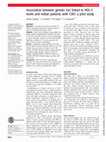
Heart Asia, 2017
Objective To examine the association between loci linked to high-density lipoprotein cholesterol ... more Objective To examine the association between loci linked to high-density lipoprotein cholesterol (HDL-C) levels and coronary artery disease (CAD). Methods A pilot study consisting of age-matched and gender-matched angiographically confirmed CAD cases (n=150) and non-CAD controls (n=150) was performed to test an association. Illumina's Human Cardio-Metabo BeadChip containing 3112 variants associated with HDL-C levels was used for genotyping. Results A preliminary analysis identified 36 variants from 16 genes that were statistically significant (p<0.05) between cases and controls. However, none of the variants remained statistically significant after correction for multiple testing. Besides, variants rs11039159 (MADD), rs749067 (MADD), rs367070 (LILRA3) and rs330921 (PPP1R3B) showed modest association with HDL-C levels. Conclusions None of the HDL-C associated loci included in this study were found to be a significant risk factor for CAD. However, the study could replicate the findings of four variants influencing HDL-C levels.
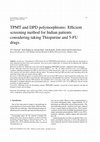
Disease Markers, 2009
Introduction: Development of DNA-based tests for TPMT/DPD polymorphisms can help clinicians and p... more Introduction: Development of DNA-based tests for TPMT/DPD polymorphisms can help clinicians and patients to make important decisions about cancer treatment. Also, due to lack of Indian data, we aimed at the development and validation of these tests in Indian patients. Materials and Methods: Molecular assays were used for identifying TPMT/DPD variations; validated by DNA sequencing. Results: Molecular assays have been used for screening TPMT*2, *3A, *3B, *3C alleles and IVS14+1(G→A) in DPD gene. A patient, exhibiting neutropenia on 6-MP was observed to be G460A-homozygote, while, two Acute Lymphoblastic Leukemia (ALL) patients with side-effects exhibited wild-type alleles. Two patients showing 6-MP side-effects and responding well to the same drug at later stage also carried wild-type alleles. Discussion: G460A homozygosity in a patient allowed clinicians to stop 6-MP treatment, improving patient's health status. Two ALL patients showing side-effects were wild-type, indicating presence of unidentified rare variations. Two patients with wild-type allele showed side-effects during 6-MP treatment, but responded well to same drug at later stage, suggesting side-effects to be attributable to multiple biological and environmental processes. Absence of IVS14+1(G→A) in DPD gene will not exclude possibility of another mutation. Conclusion: Molecular assays for determining common TPMT/DPD variations, can provide accurate diagnosis and efficient therapies in future clinical studies.
Indian Journal of Clinical Biochemistry, Jun 24, 2016
The dopamine receptor-D4 and the dopamine transporter have been investigated for their role in at... more The dopamine receptor-D4 and the dopamine transporter have been investigated for their role in attention deficit hyperactivity disorder (ADHD) in children. Reports of their genetic association with ADHD have shown mixed results. The aim of the study was to evaluate the association of variable number tandem repeats (VNTRs) of the DRD4 and DAT1 genes with ADHD in children. A pilot 1:1 case control study, with 44 clinically confirmed ADHD cases and 44 age/gender matched healthy controls, was conducted at a tertiary care centre in Mumbai. Variable number tandem repeats of DRD4 exon 3, DAT1 intron 8 and 3 0 UTR were genotyped by PCR-AGE. Several allele repeats of the genes were observed in the screened subjects. Statistical significance was observed for the 10R/10R genotype of the DAT1 3 0 UTR VNTR between cases and controls.
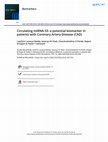
Biomarkers, Dec 9, 2018
Background: Circulating microRNAs (miRNA) are present in body fluids in stable, cell free form. L... more Background: Circulating microRNAs (miRNA) are present in body fluids in stable, cell free form. Likewise, these miRNAs can be identified in various stages of coronary artery disease (CAD) such as inflammation, endothelial dysfunction, proliferation and atherosclerosis among others. miRNA expression levels can be identified. Aims and Objectives: To determine the expression of circulating miRNAs (miR-126, miR-92, miR-33, miR-145 and miR-155) in CAD patients of Indian origin. Materials and Methods: miRNA profiling analysis in blood plasma was performed by quantitative real-time-PCR (qRT-PCR) in 60 angiographically verified subjects including 30 CAD patients and 30 age and gender matched controls. Association between the expression of all 5 circulating miRNAs and clinical characteristics of patients with CAD were analysed using Medcalc statistics. The severity of CAD was assessed using SYNTAX score (SS). Results: Expression of plasma miR-33 increased by 2.9 folds in CAD patients than in control group (p value ≥ 0.002) also it was found that miR-33 expression levels in mild cases (SS:≤22) were significantly higher than CAD controls. There was a modest negative correlation between miR-33 and total cholesterol/high density lipoprotein ratio, triglycerides and very low density lipoprotein.Conclusion: The study reports a significant association between increased levels of plasma miR-33 and CAD. Thus, plasma miR-33 appears to be a promising non-invasive biomarker, but requires further validation in a large cohort.
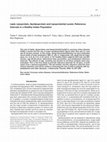
Journal of Atherosclerosis and Thrombosis, 2005
The role of lipids, lipoproteins and lipoprotein(a) [Lp(a)] in coronary artery disease (CAD) is k... more The role of lipids, lipoproteins and lipoprotein(a) [Lp(a)] in coronary artery disease (CAD) is known but the role of major apolipoproteins (apos) other than apo A-I and apo B remains unclear. In this study, using immunoturbidimetry we have estimated serum levels of total cholesterol, HDL-C, LDL-C, triglyceride, LDL-apoB and all major apos; A-I, A-II, B, C-II, C-III and E, in 751 healthy Indian subjects (470 men and 281 women, age 25-65 years), determined their percentiles, and established reference intervals. The effects of age, smoking and alcohol on all these analytes were also evaluated. This is the first study to provide reference intervals for all apos, in both sexes from a general population. The percentiles and the reference intervals have clinical relevance and will be useful in assessing the risk of CAD in patients with hyperlipidemia and other diseases.

Biomarkers, Aug 13, 2012
Thrombomodulin (TM), a natural anticoagulant have been implicated in the pathogenesis of coronary... more Thrombomodulin (TM), a natural anticoagulant have been implicated in the pathogenesis of coronary artery disease (CAD) thus emphasizing its potential role as a biomarker. To investigate the role of the TM genetic variants and soluble TM (sTM) plasma levels in Indian population with CAD. This case-control study involved genotyping of the entire TM gene and sTM levels estimation in 266 subjects. None of the four TM genetic variants identified significantly increased CAD risk in the study population. However, further subgroup analysis revealed that in subjects ≤49 years, C1418T variant (Ala455Val substitution) was significantly associated with CAD. The increased CAD risk in subjects ≤49 years due to TM Ala455Val substitution is a promising finding. Further validation on large Indian cohorts is required in order to screen asymptomatic young subjects for CAD risk and to establish the clinical utility of Ala455Val substitution.
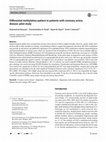
Molecular Biology Reports, Nov 23, 2018
Epidemiological studies have revealed that coronary artery disease (CAD) is highly heritable. How... more Epidemiological studies have revealed that coronary artery disease (CAD) is highly heritable. However, genetic studies have not been able to fully elucidate its etiology. Accumulating evidences suggest that epigenetic alterations like DNA methylation may provide an alternative and additional explanation of its pathophysiology. DNA methylation regulates hypomethylation and hypermethylation of various genes which are involved in the development of CAD. Our aim was to identify differentially methylated regions (DMRs) in genome of CAD patients by using the microarray chip having a coverage of > 4,50,000 CpG sites (Illumina's Infinium HumanMethylation450 BeadChip). In this pilot study, an epigenome-wide analysis of DNA methylation from whole blood was performed in six angiographically positive male cases, who were age and gender matched with six angiographically negative controls. All subjects were non-smokers, non-diabetic, non-alcoholic, with no previous history of cardiac ailment. Illumina's GenomeStudio (v 2011.1) software was used to identify DMRs and pathway analysis, gene ontology was carried out using DAVID (Database for Annotation, Visualisation and Integrated Discovery). 429 DMRs were found to be significant of which 222 were hypomethylated and 207 were hypermethylated. Antigen processing and presentation was identified to be the most significant biological function with a statistical significance of p = 4.35 × 10 − 5. HLA-DRB1, HLA-DQA1, HLA-DQB1 along with non-classical HLA molecules HLA-G, HLA-C are responsible for triggering the inflammatory pathway which have been identified in our study. To the best of our knowledge, this is the first study to identify a panel of DMRs using a high coverage microarray chip in India.
Atherosclerosis Supplements, Jun 1, 2011
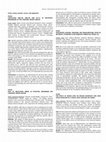
Atherosclerosis, Aug 1, 2017
Aim: Specific expression profiles of circulating microRNA (miRNAs) have been associated with seve... more Aim: Specific expression profiles of circulating microRNA (miRNAs) have been associated with several diseases such as cancer and cardiovascular injury, therefore miRNA have emerged as potential noninvasive diagnostic biomarkers of diseases. The aim of the present study was to investigate circulating miRNAs differentially regulated between patients with coronary artery disease (CAD) and healthy control subjects, and,determine their potential diagnostic value for CAD. Methods: After a microarray profile using chip-based digital PCR, miR-145, miR-155, miR-92a and let-7c were selected and validated by quantitative PCR in CAD patients (n¼69) and control subjects (n¼30) from the crosssectional study GENES. Results: The expression of miR-145, miR-155 and let-7c showed significantly reduced expression in patients with CAD compared to controls. Multivariate logistic regression analysis revealed that low levels of circulating let-7c, miR-145 and miR-155 were associated with CAD. Receiver operating curves analysis demonstrated that the combination of the three circulating miRNAs managed to deliver a specific signature for diagnosing CAD. Importantly, after adjustment for medications the levels of the three circulating miRNAs were still independently associated with CAD. Conclusions: In conclusion, we demonstrate for the first time a unique signature of circulating miRNAs for sensitive and specific diagnosis of CAD that could be translated into non invasive blood-based biomarker panels for patients. Considering that miRNAs are active molecules, our study also suggests that miR-145, miR-155 and let-7c may be instrumental in CAD pathology and could represent new targets for therapeutic interventions.

Platelets, Oct 29, 2010
Platelets play a critical role in normal blood hemostasis and thrombus formation in myocardial in... more Platelets play a critical role in normal blood hemostasis and thrombus formation in myocardial infarction (MI). Several polymorphisms of genes involved in platelet activation and fibrinolysis have been reported to be associated with MI. The aim of the present study was to determine the frequency distribution and association of polymorphisms in these genes with coronary artery disease (CAD) among Indians. A case-control genetic association study was performed for polymorphisms in platelet glycoprotein receptors (GPIIb/IIIa [HPA1a/1b], GPIb-IX-V [VNTR], and GPIa/IIa [C807T]), fibrinogen β-chain (BclI), α-chain (Aα312), tissue plasminogen activator (tPA) [I/D] and plasminogen activator inhibitor-I (PAI-1) [4G/5G] in 473 healthy controls and 446 patients with stable and unstable angina. Genotyping was either by PCR-based restriction endonuclease digestion or allele-specific primers. The I allele frequency of the tPA I/D polymorphism was significantly higher in our patients (χ(2)=7.33, P&amp;amp;amp;amp;amp;amp;amp;amp;amp;amp;amp;amp;amp;amp;amp;amp;amp;amp;amp;amp;amp;amp;amp;amp;amp;amp;amp;amp;amp;amp;amp;amp;lt;0.01) and no other polymorphisms varied significantly between patients and controls. Also, none of the polymorphisms seemed to affect the severity of the disease, the only exception being the mutant alleles of β chain of fibrinogen gene, which were significantly elevated in single vessel disease. This is the first study to evaluate the role of gene polymorphisms in both the thrombotic and fibrinolytic pathway in the Indian population and suggests that tPA I/D polymorphism confers CAD risk in our population.
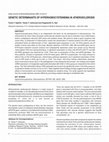
Indian Journal of Clinical Biochemistry, Sep 1, 2006
Hyperhomocysteinemia (Hhcy) is an independent risk factor for the development of atherosclerosis.... more Hyperhomocysteinemia (Hhcy) is an independent risk factor for the development of atherosclerosis. The mechanisms by which HHcy promotes cardiovascular disease may be due to activation of pro-inflammatory factors, endoplasmic reticulum (ER) stress and oxidative stress. We aimed to study (i) gene mutations that cause HHcy. (ii) Estimation of inflammatory marker like ultrasensitive C-reactive proteins (hs-CRP) and total antioxidant levels (iii) determination of Hcy-dependent gene expression in vivo. 25 HHcy patients and 25 healthy controls were taken for this study. Mutation detection in MTHFR, CBS, MS and eNOS gene was by PCR-based restriction enzyme analysis and subsequently expression study was carried out by Reverse Transcriptase PCR and cloning technique. A significant association of HHcy with MTHFR (C677T) and MS (A2756G) genotype was observed (p< 0.05). There was no association of Hhcy and eNOS genotype. The Hhcy patients, showed no expression of the ER stress gene, GRP78 in lymphocytes. Our study showed no effect of Hcy on the CD18 gene (pro-inflammatory pathway) expression, but a significant association of tHcy and hs-CRP levels in HHcy grp (t=2.28, p< 0.05). This shows that HHcy induces inflammatory response, which could lead to tissue injury in the pathogenesis of the atherosclerotic process. Our findings show higher mRNA expression of manganese superoxide dismutase (Mn SOD) in HHcy group as compared to the control group .The Total Antioxidant Status (TAS) estimated was found to be significantly lower in the HHcy group as compared to healthy normals (t=4.8, p<0.01). Taken together these findings strongly suggest that the adverse effects of homocysteine are at least partly mediated by oxidative stress. Our study supports the hypothesis that Hcy evokes adverse vascular effects by promoting oxidative damage to endothelial cells.

Molecular Diagnosis, Jun 1, 2005
Cystic fibrosis (CF) is an autosomal recessive disorder caused by mutations in the CFTR gene. The... more Cystic fibrosis (CF) is an autosomal recessive disorder caused by mutations in the CFTR gene. The most severe, DeltaF508, mutation accounts for nearly 70% of CF cases worldwide. Besides DeltaF508, there are other point mutations, namely G542X, G551D, R553X, N1303K, and 621+1(G--&amp;amp;amp;amp;amp;amp;amp;amp;amp;amp;amp;amp;amp;amp;amp;amp;amp;amp;amp;amp;amp;amp;amp;amp;amp;amp;amp;amp;amp;amp;amp;amp;amp;amp;amp;amp;amp;amp;amp;amp;gt;T), which are common among Caucasians. Additionally, a polyT polymorphism in intron 8 is also involved in the pathogenesis of CF. However, neither the prevalence nor the types of mutations causing CF in India are known. In this study, we aimed at estimating the frequency of the above common mutations and polymorphism in clinically suspected CF cases. We also carried out partial analysis of the CFTR gene, limited to exons 10 and 11, to identify other variations in these exons. The multiplex amplification refractory mutation system (ARMS) test was applied for rapid simultaneous analysis of six most common CF mutations, in 100 normal and 39 elevated sweat chloride cases. The scanning of exons 10 and 11 was carried out by single-stranded conformation polymorphism/heteroduplex (SSCP/HD) analysis, followed by DNA sequencing in 50 normal and 37 elevated sweat chloride cases. A single ARMS-polymerase chain reaction assay was used to distinguish the 5T, 7T, and 9T alleles in 100 normal and 33 elevated sweat chloride cases. The multiplex ARMS analysis identified the DeltaF508 mutation at an allele frequency of 24% in Indian CF cases. However, the other predominant CF mutations were found to be absent. The 7T polyT variant was observed to be the most common allele, followed by the 9T, and 5T, which was the lowest. The DeltaF508 mutation was observed in all instances with the 9T variant. The SSCP/HD and DNA sequencing additionally revealed a known polymorphism (M470V, exon 10) and a known mutation [1525-1(G--&amp;amp;amp;amp;amp;amp;amp;amp;amp;amp;amp;amp;amp;amp;amp;amp;amp;amp;amp;amp;amp;amp;amp;amp;amp;amp;amp;amp;amp;amp;amp;amp;amp;amp;amp;amp;amp;amp;amp;amp;gt;A), intron 9]. The 1525-1(G--&amp;amp;amp;amp;amp;amp;amp;amp;amp;amp;amp;amp;amp;amp;amp;amp;amp;amp;amp;amp;amp;amp;amp;amp;amp;amp;amp;amp;amp;amp;amp;amp;amp;amp;amp;amp;amp;amp;amp;amp;gt;A) mutation, observed in a single 4-year-old male, is predicted to code for a class II defective CFTR protein. The findings of this study suggest a difference in relative frequencies and spectrum of CFTR mutations in Indian CF cases. A larger screening study of the entire CFTR gene in clinically well defined CF cases is required to delineate common mutations in the CFTR gene and enable molecular diagnosis of CF in India.










Uploads
Papers by Tester Ashavaid